Life at the Lake
a diary of living at a small lowland lakeWHAT IT'S LIKE
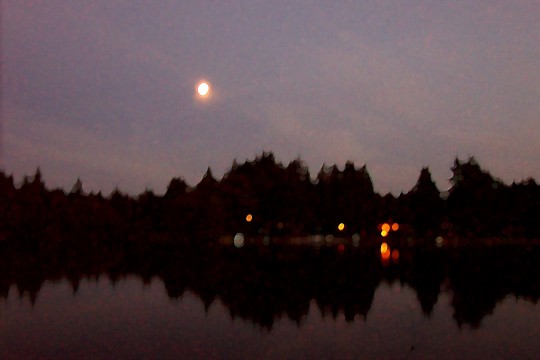
Early moonrise over Lake Ketchum
|
Archive Search |
| Links |
|
and s-integrator |
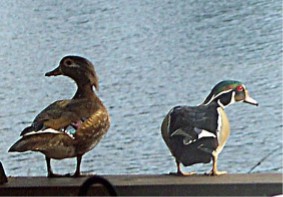
The male woodie is the one on the right
Though the first mallard brood has been sighted, proudly steaming up lake center a couple of days ago, the wood ducks have not appeared yet with their ducklings.
But there are certain signs I'd say are positive.
First, male and female wood ducks only occasionally appear together, usually early in the morning and again at dusk, though not always. The hen is on the nest or, rather, in the wood duck box fifteen or twenty feet up on a tree, within a short glide of the water. My book tells me she will produce an egg a day for the duration. And—remember; I sure do—my first sight of a pair copulating.
I felt like I'd beheld a holy event.
Well, now that she is on the nest, most all the while, the males are free of responsibilities and tend to congregate along the shoreline. Yesterday, three of the splendidly dressed guys, looking a bit like Marines in their full-dress uniforms. (There is no better word for them than gaudy. )
They walked around the edges of my dock looking much more formal and regal than they really are, then in a silly little motion, on after the other, hopped the eighteen inches up to the cedar, walked around ceremoniously ludicrously flatfootedly, gazing out across the lake, ignoring each other. One of them pooped.
Then, one by one, they hopped neatly back down to the water's surface and swam idly a way.
I hope for the first slender brood in a day or two. (There are never as many of them as I'd hoped for, and the attrition rate is chilling.)
- - Comments ()
...

A rose, not plastic
DUSTING THE ROSES
I know, roses don't last long enough to require dusting, but mine do. They were a gift from a neighbor who was a paint salesman for, first, Fuller, then Parker, and the roses are plastic. I don't believe they are silk. And Marshall, my next door neighbor, got them as part of a promotion and then had many left over.
They came by the dozen and are all red, and in the bud. They are very pretty, though as phony as can be. I put the first bunch in an idle one-quart Mason jar. There they have resided, ever since. This has been about ten years.
"You like them?" he said, when I warily accepted them, with a lot of thanks. "Here—have another dozen."
I took them, wishing they were yellow, but they only came in red. Now I had two dozen identical roses.
How lifelike they looked. I couldn't really throw them away. (Yes, I could have, I know.) They were not common then. Now every notions store such as Michaels has rows and rows of such artificial flowers and they are of infinite variety and size. They are much better than my paint-promotional red roses. Yet I've chosen to retain mine. Call it for sentimental reasons. Okay then, because I am too cheap to throw them out. Besides, I like them.
But they require periodic dusting. I must dusty my roses, or resist doing so (easy, easy), and live with dusty roses.
A dusty rose, let alone a dozen of them, let alone two dozen of them, is not a pretty thing. Well, it is still pretty, I should say, but its prettiness is somewhat diminished by a thin layer of some white/gray substance.
You could argue, as I annually do, that the dust enhances them, but it really doesn't. I concede to the need for cleanliness by going over to where they reside on an unused wood stove and blowing on them hard.
Doing so reduces the dust by about five percent. I'd say that is about enough.
And of course writing about them proves that not only are they beautiful but useful.
- - Comments ()
...
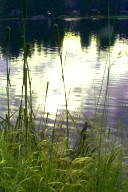
Wetland grasses where mallards nest
On the center of the lake this morning, streaming West, appeared a mother mallard and her new brood. The year's first: the hope now is for the wood duck ducklings soon to appear. Anyway, she seemed proud of the fuzzy golden babies, or perhaps that is my seeing them through the pathetic fallacy, which invests naturally occurring events with human, or even religious, values. This is usually wrong.
At any rate she was not shy about them and the center of the lake at its widest point probably offered her and them protection from predators. Otters, raccoons, cats, rats, even bullfrogs, I hear, are their natural enemy. Her brood numbered about seven—my wife and I could not agree or get a good count because the ducklings behaved almost as one, bunched goldenly together, with only occasionally a trailing stray scurrying in panic to catch up with the others.
She seemed almost oblivious to them, which was all an act, of course. She knew all of their locations. Her beady eye continually scanned the area behind her with great peripheral vision. Part of their education was to keep up the others. It is necessary for their survival.
Our seventh summer here approaching, we have never gotten used to seeing the brood slowly decimated, usually one by one, and we annually speculate on what happens to each of them. It is always unknown.
In each instance it was probably food for some critter. Biologists tell us now it is no longer a "food chain." It is a "food web."
I can dig it.
- - Comments ()
...
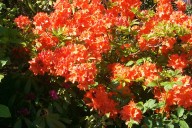
Site of the Murder
It was a sunny day, the grass dry for once, so I thought I'd cut the grass. Good idea.
It was a sunny day, so the garter snake thought it would come out and take a sun bath. Bad idea.
My mower is manual and ergodynamic, which means I must push it hard, though it is designed to rotate its blades on its shaft with minimal effort. Ha.
I bought it from L.L. Bean five or six years ago and aside from a little oil, now and then, and clearing wet cut grass blades from around the shaft, it requires no maintenance. My neighbor, whose many tools are all gasoline powered and noisy, laughs at me and my amateurishness. He is a high-school gym teacher and works out daily so his students won't laugh at his body behind his back. But he requires power tools. Figure that out.
So I begin cutting, moving the mower in swathes that slightly overlap so that there will be no unsightly uncut lines between rows. Since my wife gardens extensively, she has neat borders of rocks marking where her turf leaves off and mine begins, and I am sometimes reminded that I need to expend special attention to the lines of demarcation. In other words, I am not to cut her flowers or vegetables, nor run my mower's wheels into those beds.
Okay. So I am mowing along, paying close attention to the borders, when I spot a garter snake. He is, I'd say, three-quarters of the way out of his hole.
"His hole?" That's right. I always knew they lived in holes in the ground, but I'd never seen one emerge, or for that matter, submerge.
He looked around, but not at me. A threat was posed. His little tongue prettily flickered. I halted. Snake backtracked into his hole and disappeared. I mowed on.
Coming back a minute or two later, I saw the snake again. He was nearly fully emerged and there was something wrong with him. Or her, as the case may be. He was a damaged snake. Evidently I had hit him with the mower, that first time over our mutual turf.
He didn't look right. He glanced around and resubmerged by slow degrees. It was an interesting spectacle. By inches he disappeared back into his hole. I wondered how he did it. He must some physical means of reverse locomotion. It was like watching a tape of a snake leaving his hole run backwards.
Okay. I cut on, but the image of the snake remained fixed in my mind. Another minute or two and I came by again, but this time a couple of rows farther away. Again the snake. But this time he was fully extended and I could see two bloody wounds on his dark reptilian body. No doubt about it, I had hit him on that first pass. And I felt just terrible about it.
I halted and watched him slither away. (I'd always wanted to write that sentence and have it be literally true.) He moved in that sweet sideways motion of a snake into the base of a blooming azalea and . . . disappeared.
But in the eye of my mind I could see those two dark red bands on his body.
They were wounds and ones I had unknowingly inflicted. No doubt he (or she) would die, and die soon. In among the azalea's orange blooms.
It was a pretty place, as pretty a place as there must be in which to die.
And—lowly snake or not—I felt just terrible about what I had done.
- - Comments ()
...

Benois sculpture for Pushkin's "The Bronze Horseman"
Ah, Shostakovich! The most American of composers!
About bedtime, a few months ago, I turned the TV dish receiver to my favorite digital music station and heard the most exciting music begin. I settled into my chair and for the next 50 minutes or so listened to Shostakovich's Seventh Symphony, The Leningrad. Now, I suppose everybody but me was familiar with it, and with "Shosty's" other music.
Not I. He was just another 20th century composer, and a foreign one at that.
Still I sat, transfixed, and when it was over I slid into my bed in a kind of glow similar to the one I had experienced at age 19, after finishing James Joyce's Ulysses, about two AM.
Such events are seminal and rare in one's life.
Can you whistle Shosty, as you can Tchaikovsky? Not so easily, but, yes you can. And I do, all the time around the house.
What I am hearing now by that great musical master is his 24 Preludes and Fugues, Opus 87, played by his friend Tatiana Nikolayeva, who accompanied him to Leipzig for the 200th anniversary of Bach's death. Shosty was an honorary juror for the piano competition. Tatiana offered to play any one of the 48 preludes and fugues by Bach. She won the international competition. Afterwards they returned home to Moscow.
Inspired by Bach's Well-Tempered Clavier, Shosty went right to work creating his own modern-day (well, it was 1950) version of the musical forms. They took him only five months. They number but half the ones that Bach did, but they are mathematically the equivalent, and are delightfully dissonant. Yet the homage to Bach is apparent throughout.
You have to listen hard in order to hear it, though.
- - Comments ()
...
"Blog?"
What kind of word is that? Sounds like you started out to say one thing but ended up mouthing another. It is a sound, not a word. It is meaningless until you invest it with meaning, which may not work and therefore will be unsuccessful.
"Captain Hook hit him with his blog, and he keeled over."
"Get your hand off my blog!"
"Running across the moor, he fell into a blog and drowned."
Words normally of one syllable, like "blog," actually are pronounced as two because the first consonant is made with the lips pursed and the second and adjacent consonant is made with the tongue far back in the mouth, and the distance the lips and tongue have to travel is sufficient to cause a pause ("cause a pause" rhyme , you'll notice, and are a form of hiphop), and the pause is the same length as a spoken syllable and, in effect, becomes one.
Thus:
"bal-og"
If you try to say it as one syllable (just try it!), it is very much like spitting, and nobody wants to be seen spitting in public, so the word is never, never, never to be spoken when other people are around. And if you say it when you are alone, well, you are guilty of talking to yourself, something we are all inclined to do as we grow older.
And where does the accent lie? Is it "bla/-log" or is it "bla-log/"? What's the difference? And who cares?
Since it is short, very short, for "Weblog," why don't people say, "We-blog?" Well, they simply don't. Blogs are generally singular, that is, written by one person, to glorify (right word?) that person, and rarely are written by consensual committee.
Just try to get a committee to write something. It is like herding chickens. What do you mean, "You've never tried to herd chickens." Who has? But we've all worked in committee. Don't you have an imagination? Well, try to imagine it. First, though, you have to have had some experience with chickens, herding them or not.
Tomorrow: Does God exist, and why does He or She keep hiding? The definitive answer.
- - Comments ()
...
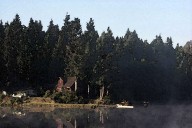
Typical Year-Round Lakefront Home
Once a year, the lake monitors for Snohomish County get together—sometimes at somebody's lake, sometimes at the Surface Water Utility offices in Everett, and compare notes.
We are a remarkably dissimilar group that share a single interest—the biological welfare of the lake each of us lives upon. In our county, each lake is what is termed a lowland lake and has similar characteristics, the chief one of which is that it is apt to be inundated with phosphorous from nearby farms. The dairy farms are the worst, and the worst of the worst are those farms that raise milk cows.
Lake Ketchum is one such lake and (I say this not proudly) has a phosphorous/nitrogen input that is four or five times as much as its nearest competitor. The growth of weeds and algae is so great that we must, reluctantly, treat our lake with a herbicide or else be inundated with one form of greenery or another from bank to bank.
It is expensive to treat a lake, even a small lake such as ours, and to raise the money we have been organized into a local improvement district. We tax ourselves about $2 a front foot for our lakefront property, then hire a professional to spray the shore one or two times a year with stuff called Sonar, or floridone.
This kills most of the weeds, including the beneficial ones, but doesn't touch the green algae, which we learned last year was most likely Spirogyra. In fact, treating the lake for weeds may actually increase the amount of algae, which in excessive amounts may deprive the lake of the dissolved oxygen that is necessary to all life.
Other lakes have problems different from mine.
One—Cranapple—is small and deep, and has inadequate drainage. During the winter its height on the land may rise or fall by six feet. Homes and lands are subjected to flooding. I always feel fortunate when I hear about the plight of Cranapple, though I tend to be inadequately commiserated with on my problem with phosphorous super-abundance.
It is a pleasant, cheerful group, though this year I was surprised by the amount of attrition. Some of the old-time monitors have moved away. Others have tired, I guess, of the amount of monitoring work that is involved and resigned. There were a number of "new hires," or newly volunteered monitors, who seemed uniformly dedicated and eager. I liked them all immediately.
We took time to compare notes, ask each other if the other's lake was suffering from early algae problems, pin on name tags and peer a bit rudely at each other's tag, immediately forgetting the new name we had been so eager to inspect. The program included a fine presentation on species of fish and the problems of managing them by the area representative from the state Fish and Wildlife. This was followed by the program's director telling us about West Nile Disease, carried by mosquitoes from the bodies of dead birds, usually crows. It produces flu-like symptoms. Then a retired timber company executive told us about the exhaustive personalized monitoring program he had set up at his lake, Panther, on a site of a former camp.
Perhaps he is trying to atone for historical environmental wrongs committed by the industry he spent his lifetime working in, or else he is a new "Green," bored by retirement, and zealously dedicated to knowing and measuring his lake. His biggest accomplishment was taking nearly continuous dissolved oxygen (DO) readings throughout the year at many different depths, since Panther is several times deeper than most of the other lakes, including mine.
He documented how lakes "turn over" in the fall, mixing different temperature stratifications and DO contents so that they all become the same, about the end of October, each year. It is quite a marvelous process and explains how lakes are refreshed in winter for the coming cycles of sunlight and growth. All of our lakes undergo this process, of course, but we had not seen it so well explained and presented.
The formal part of the meeting over, we settled down to more coffee and soft drinks, plus huge wedges of pizza provided by the county as our little reward for attending.
Enthused, renewed (as is the lake by turning over in late autumn), we settled down to more chitchat about lakes. Who says there is no free lunch?
- - Comments ()
...
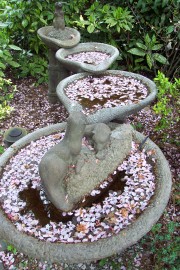
The Four Otter Fountain and Cherry Petals
Once a year, the lake monitors for Snohomish County get together—sometimes at somebody?s lake, sometimes at the Surface Water Utility offices in Everett, and compare notes.
We are a remarkably dissimilar group that share a single interest?the biological welfare of the lake each of us lives upon. In our county, each lake is what is termed a lowland lake and has similar characteristics, the chief one of which is that it is apt to be inundated with phosphorous from nearby farms. The dairy farms are the worst, and the worst of the worst are those farms that raise milk cows.
Lake Ketchum is one such lake and (I say this not proudly) has a phosphorous/nitrogen input that is four or five times as much as its nearest competitor. The growth of weeds and algae is so great that we must, reluctantly, treat our lake with a herbicide or else be inundated with one form of greenery or another from bank to bank.
It is expensive to treat a lake, even a small lake such as ours, and to raise the money we have been organized into a local improvement district. We tax ourselves about $2 a front foot for our lakefront property, then hire a professional to spray the shore one or two times a year with stuff called Sonar, or floridone.
This kills most of the weeds, including the beneficial ones, but doesn?t touch the green algae, which we learned last year was most likely Spirogyra. In fact, treating the lake for weeds may actually increase the amount of algae, which in excessive amounts may deprive the lake of the dissolved oxygen that is necessary to all life.
Other lakes have problems different from mine. One?Cranapple?is small and deep, and has inadequate drainage. During the winter its height on the land may rise or fall by six feet. Homes and lands are subjected to flooding. I always feel fortunate when I hear about the plight of Cranapple, though I tend to be inadequately commiserated with on my problem with phosphorous super-abundance.
It is a pleasant, cheerful group, though this year I was surprised by the amount of attrition. Some of the old-time monitors have moved away. Others have tired, I guess, of the amount of monitoring work that is involved and resigned. There were a number of ?new hires,? or newly volunteered monitors, who seemed uniformly dedicated and eager. I liked them all immediately.
We took time to compare notes, ask each other if the other?s lake was suffering from early algae problems, pin on name tags and peer a bit rudely at each other?s tag, immediately forgetting the new name we had been so eager to inspect. The program included a fine presentation on species of fish and the problems of managing them by the area representative from the state Fish and Wildlife. This was followed by the program?s director telling us about West Nile Disease, carried by mosquitoes from the bodies of dead birds, usually crows. It produces flu-like symptoms. Then a retired timber company executive told us about the exhaustive personalized monitoring program he had set up at his lake, Panther, on a site of a former camp.
Perhaps he is trying to atone for historical environmental wrongs committed by the industry he spent his lifetime working in, or else he is a new ?Green,? bored by retirement, and zealously dedicated to knowing and measuring his lake. His biggest accomplishment was taking nearly continuous dissolved oxygen (DO) readings throughout the year at many different depths, since Panther is several times deeper than most of the other lakes, including mine.
He documented how lakes ?turn over? in the fall, mixing different temperature stratifications and DO contents so that they all become the same, about the end of October, each year. It is quite a marvelous process and explains how lakes are refreshed in winter for the coming cycles of sunlight and growth. All of our lakes undergo this process, of course, but we had not seen it so well explained and presented.
The formal part of the meeting over, we settled down to more coffee and soft drinks, plus huge wedges of pizza provided by the county as our little reward.
Enthused, renewed (as is the lake by turning over in late autumn), we settled down to more chitchat about lakes. Who says there is no free lunch?
- - Comments ()
...
Once a year, the lake monitors for Snohomish County get together—sometimes at somebody?s lake, sometimes at the Surface Water Utility offices in Everett, and compare notes.
We are a remarkably dissimilar group that share a single interest?the biological welfare of the lake each of us lives upon. In our county, each lake is what is termed a lowland lake and has similar characteristics, the chief one of which is that it is apt to be inundated with phosphorous from nearby farms. The dairy farms are the worst, and the worst of the worst are those farms that raise milk cows.
Lake Ketchum is one such lake and (I say this not proudly) has a phosphorous/nitrogen input that is four or five times as much as its nearest competitor. The growth of weeds and algae is so great that we must, reluctantly, treat our lake with a herbicide or else be inundated with one form of greenery or another from bank to bank.
It is expensive to treat a lake, even a small lake such as ours, and to raise the money we have been organized into a local improvement district. We tax ourselves about $2 a front foot for our lakefront property, then hire a professional to spray the shore one or two times a year with stuff called Sonar, or floridone.
This kills most of the weeds, including the beneficial ones, but doesn?t touch the green algae, which we learned last year was most likely Spirogyra. In fact, treating the lake for weeds may actually increase the amount of algae, which in excessive amounts may deprive the lake of the dissolved oxygen that is necessary to all life.
Other lakes have problems different from mine. One?Cranapple?is small and deep, and has inadequate drainage. During the winter its height on the land may rise or fall by six feet. Homes and lands are subjected to flooding. I always feel fortunate when I hear about the plight of Cranapple, though I tend to be inadequately commiserated with on my problem with phosphorous super-abundance.
It is a pleasant, cheerful group, though this year I was surprised by the amount of attrition. Some of the old-time monitors have moved away. Others have tired, I guess, of the amount of monitoring work that is involved and resigned. There were a number of ?new hires,? or newly volunteered monitors, who seemed uniformly dedicated and eager. I liked them all immediately.
We took time to compare notes, ask each other if the other?s lake was suffering from early algae problems, pin on name tags and peer a bit rudely at each other?s tag, immediately forgetting the new name we had been so eager to inspect. The program included a fine presentation on species of fish and the problems of managing them by the area representative from the state Fish and Wildlife. This was followed by the program?s director telling us about West Nile Disease, carried by mosquitoes from the bodies of dead birds, usually crows. It produces flu-like symptoms. Then a retired timber company executive told us about the exhaustive personalized monitoring program he had set up at his lake, Panther, on a site of a former camp.
Perhaps he is trying to atone for historical environmental wrongs committed by the industry he spent his lifetime working in, or else he is a new ?Green,? bored by retirement, and zealously dedicated to knowing and measuring his lake. His biggest accomplishment was taking nearly continuous dissolved oxygen (DO) readings throughout the year at many different depths, since Panther is several times deeper than most of the other lakes, including mine.
He documented how lakes ?turn over? in the fall, mixing different temperature stratifications and DO contents so that they all become the same, about the end of October, each year. It is quite a marvelous process and explains how lakes are refreshed in winter for the coming cycles of sunlight and growth. All of our lakes undergo this process, of course, but we had not seen it so well explained and presented.
The formal part of the meeting over, we settled down to more coffee and soft drinks, plus huge wedges of pizza provided by the county as our little reward.
Enthused, renewed (as is the lake by turning over in late autumn), we settled down to more chitchat about lakes. Who says there is no free lunch?
- - Comments ()
...